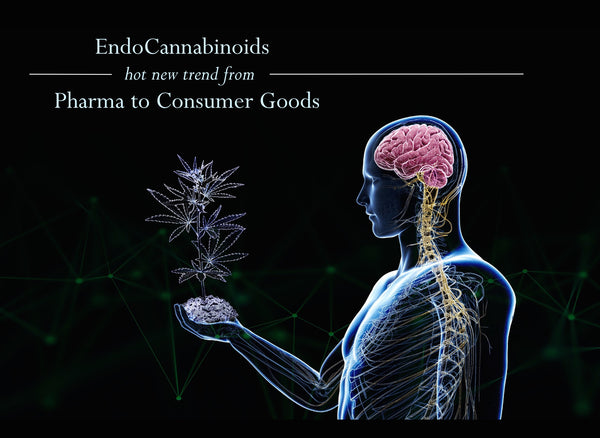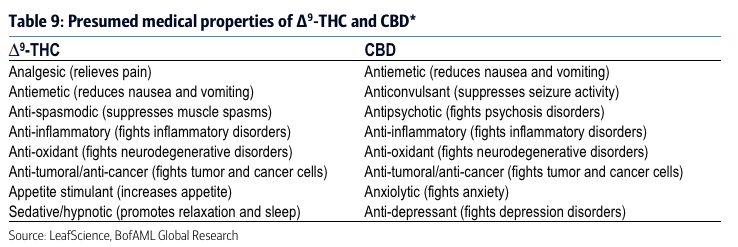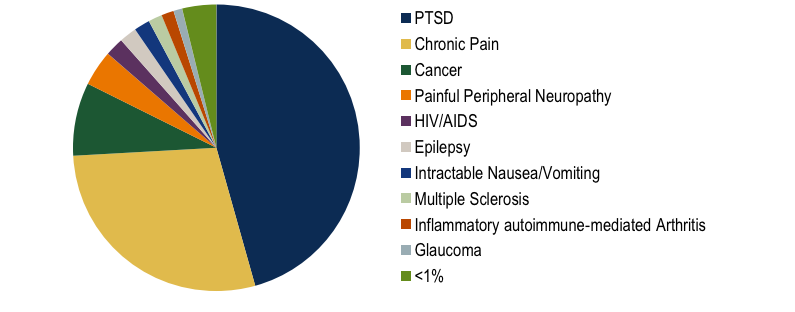Cannabinoids: new hot trend from Pharma to Consumer goods

Article submitted by: www.globalhealthlab.com
Thanks to Cannabis plant "renaissance" in a next decades we will witness not only incredible medical discoveries, but an avalanche of consumer goods that are based on cannabis from food, beverages, cosmetics to pet food.
The potential for such prediction is hidden in so called Endocannabinoid human system that seems to be functioned on the same phyto-cannabinoids that could be isolated from Cannabis plant. THC and CBD are two best-studied phyto-cannabinoids (but at least 113 different cannabinoids have been isolated from the cannabis plant till todays). While THC and CBD have the same chemical formula, C21H30O2, they are two different isomers and possess different properties.
Endocannabinoid (eCB) system seems to be a focal point of essential body systems and acts like "remote control" in order to regulate them. In a simple terms, Endocannabinoid (eCB) system notice to be involved in regulation:
- central and peripheral nervous system
- hormonal or endocrine system
- and even immune system.
ECBs is the body’s deeply intrinsic system of cannabinoid molecules, ligands, enzymes, transporter proteins and receptors, most notably CB1 and CB2 receptors that interact. Produced in a variety of cells, eCBs molecules are not stored, but generated as needed.
- CB1 receptors are mainly associated with the central nervous system (CNS) and involve in neuroendocrine functions, neurogenesis.
- CB2 receptors are mainly found in peripheral nervous system and in cells of the immune system such as B lymphocytes, T lymphocytes, leukocytes, macrophages, monocytes and natural killer (NK) cells with high concentration in spleen, tonsils, and thymus gland.
- eCBs also interact with non-CB1/CB2 receptors such as TRPVs, 5-HTs, and PPARs. There are many other potential candidates to be named as new Cannabinoid receptors, like: GPR55, GPR18, GPR119 etc., further study required.
Cannabinoid receptors are activated by cannabinoids, generated naturally inside the body (endocannabinoids) or introduced into the body as phytocannabinoids. After the receptor is engaged, multiple intracellular signal transduction pathways are activated.
THC works directly both way and could activate and block CB1 and CB2 receptors that depend on density and coupling efficiencies of these receptors. It is now well studied that THC is a cannabinoid CB1 and CB2 receptor partial agonist and that depending on the expression level and coupling efficiency of CB1/CB2 receptors it will either activate them or block their activation by other cannabinoids.
Cannabidiol has a very low affinity for CB1/CB2 receptors but acts as an indirect antagonist and is thought to potentiate the effects of Δ9-THC. Cannabidiol is reported to act as an CB2 receptor inverse agonist, GPR55 antagonist, and a 5-HT1Areceptor agonist. It can allosterically modulate μ and δ-opioid receptors as well as agonize PPARγ receptors and stimulate intracellular calcium release.

Altogether, the eCB system has complex modulatory effects on a range of physiological and pathological functions involving metabolism, inflammation, pain, cancer, neurotransmission and cognition along with others.
The intensive research on the structure and activity of phytocannabinoids and endocannabinoids has lead to the development of synthetic compounds with high potency and selectivity for cannabinoid receptors. These synthetic cannabinoids have opened new avenues for targeting of the endocannabinoid system using selective cannabinoid receptor ligands with improved pharmacotherapeutic potential and limited toxicity.
For example such drugs as Marinol, genetically dronabinol, or Cesamet, also called nabilone, are synthetic cannabinoid that does not naturally appear in cannabis, taken orally as a pill for chemotherapy-induced nausea and vomiting.
Sativex, also called nabiximols, is an oral spray derived from cannabis and is a 1:1 combination of THC and CBD for patients with moderate to severe multiple sclerosis (MS) spasticity.
Cannabis therapeutics use in the US in 2016 is shown in diagram below:

Treatment of epilepsy with CBD is the most highly anticipated advance to come from cannabinoid therapeutics in our opinion.
Therapeutic potential with Cannabinoids
Chronic pain. As previously discussed, more than 90% of patients that use medical cannabis report chronic pain as their qualifying condition. This might include, but is not limited to, pain related to cancer, arthritis, fibromyalgia, migraine, neuropathic pain (pain caused by damaged or diseased nerves), HIV sensory neuropathy or spinal injury. Although the mechanisms by which cannabinoids induce analgesic effects are not explicitly clear, cannabinoids can modulate nociceptive neurons, provide euphoric sensations and reduce inflammation. The widespread use of cannabis for severe pain combined with the acknowledged physiological effects suggests that cannabinoids could have a permanent place in pain management.
Neurodegenerative diseases. The pharmacological effects of cannabinoids implicate their use in the spectrum of neurodegenerative diseases including Alzheimer’s disease, Huntington’s disease, stroke/brain trauma, Parkinson’s disease and amyotrophic lateral sclerosis (along with multiple sclerosis). The neuroprotective properties of cannabinoids are rooted in their supposed regulation toward cellular homeostasis, including cell survival or death. Interestingly, the eCB system changes in neurodegenerative diseases with altered CB receptor and endocannabinoid expression, and synthesis and degradation of endocannabinoids.
Inflammatory diseases. Cannabinoids have been well documented to play a role in inflammation owed to the fact that CB2 receptors are highly expressed by immune cells, activation of CB1/2 receptors can regulate inflammatory signals and CBD can also mediate inflammatory activation through non-CB receptors. Common responses to cannabinoids observed in vivo have been reduction in oxidative stress and inflammatory cell tissue infiltration, as well as reduced pro-inflammatory transcription factor NF-kB target gene expression. Accordingly, cannabinoids may have potential in treating inflammatory diseases such as inflammatory bowel diseases (IBDs) or arthritis.
Rheumatoid arthritis. Because CB2 receptors are located on the inflammatory cells that infiltrate rheumatoid joints and on cells within joints (called fibroblasts), they can be targeted to mediate joint inflammation and pain. CB2 activation suppresses secretion of inflammatory signals from fibroblasts and immune cells, and has been shown to stop progression of rheumatoid arthritis in animal model.
Cancer. Cannabinoid therapeutics may be suited for the battle against cancer itself by directly inhibiting cancer growth. The mechanism may be several-fold including anti-inflammatory, anti-proliferative, anti-metastatic and proapoptotic action. Currently under investigation is the use of cannabinoids in treating glioma, tumors that arise in the supportive tissue of the nervous system and account for 80% of brain tumors.
Evidence that cannabinoids may be useful in reducing growth in a variety of tumor types exists including breast, prostate, lung, skin and bone cancer. Cannabinoids may be able to regulate cancer-associated pathways including MMP production, PI3K/AKT, RAF1/ERK1/2, JNK/AKT, MAPK/ERK and p38. Still, cannabinoid therapeutics for cancer is in its infancy, and there is no evidence that suggests cannabinoids will improve upon currently available therapies.
Diabetes. The interest in using cannabinoids to treat metabolic diseases such as obesity goes deeper with studies reporting that CB1 receptor blockade may prevent death of pancreatic islet cells, implicating the eCB system in diabetes. CBD has been shown to prevent progression of diabetes in mice. Cannabinoids have also been suggested to have the capability to mediate oxidative stress caused by hyperglycemia associated with diabetes.
Fibromyalgia. Currently on the market, there few medical patches from cannabis that treat fibromyalgia and diabetic nerve pain. The plaster contains concentrated cannabinoid (CBD) extract that slowly penetrate the skin as the body’s heat melting a thin layer of medication.
Cannabinoids in consumer goods products
Cannabis that is used for regular consumer consumptions called Hemp. Thus popular products ready to eat are: Hemp heart seeds, Hemp oil, Hemp protein, Hemp milk, Hemp tea, Hemp infusion drink. All of these products contain trace amount of cannabinoids, but amount may vary and depend on cannabis plant species. Therefore, by eating Hemp derivatives, body will get some small amount of phyto-cannabinoinds that will support and stimulate production of endocannabinoids (produced by body) in case of cannabinoid deficiency.
Hemp is also broadly used in beauty, and cosmetic industry, because of excellent dermatological properties. There are plenty shampoos, balms, creams, toners, skin care lotions, moisturizers.
Hemp textile is known as one of the strongest and most lasting organic fibers. Clothing made from hemp will outlast by many years. Probably that is why, first original Levi Strauss jeans were made from hemp and made its reputation as "can't be ripped" and "for rough going".
Hemp paper, for example, does not goes yellow with the time. It's much cheaper technologically to produce paper from hemp (less toxic chemicals for bleaching), less time to grow Hemp (only 120 days vs 20-50 years for trees), and less energy consumption during production. Hemp paper could be recycled many-more time than tree-based paper.
Summarizing it, either you choose Cannabis medicine or Hemp food products, you will be surprise of many benefits that this plant possess. We hope in nearby future, cannabis pharma, cosmetics, and food industry will experience substantial growth and will bring more scientific data about cannabinoids properties.

